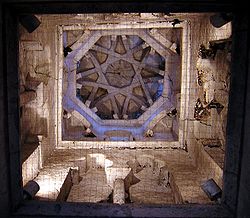
Mosque of Cristo de la Luz
Encyclopedia

Toledo, Spain
Toledo's Alcázar became renowned in the 19th and 20th centuries as a military academy. At the outbreak of the Spanish Civil War in 1936 its garrison was famously besieged by Republican forces.-Economy:...
, the only one of the ten once existing in the city which remains largely as it was in the Moorish
Al-Andalus
Al-Andalus was the Arabic name given to a nation and territorial region also commonly referred to as Moorish Iberia. The name describes parts of the Iberian Peninsula and Septimania governed by Muslims , at various times in the period between 711 and 1492, although the territorial boundaries...
period. It was then known as Mezquita Bab-al-Mardum, deriving its name from the city gate Bab al-Mardum
Puerta Bab al-Mardum
The Puerta Bab al-Mardum, or Puerta de Valmardón, is a city gate of Toledo, Spain. It was built in the 10th century and is probably the oldest gate of the city. Its name 'mardum' is Arabic for 'blocked up'. Perhaps because its function was taken over by the Puerta del Sol. The Spanish name...
. It is located near the Puerta del Sol
Puerta del Sol, Toledo
Puerta del Sol is a city gate of Toledo, Spain, built in the late 14th century by the Knights Hospitaller.The medallion above the arch of the gate depicts the ordination of the Visigothic Ildephonsus, Toledo's patron saint...
, in an area of the city once called Medina where wealthy Muslims used to live.
Architecture
The mosque is a small building, measuring about 8 x 8 m. Four columns capped with Visigothic capitals divide the interior into nine compartments. Above these are nine vaults, each with a distinctive design.Behind this square section, a Mudéjar
Mudéjar
Mudéjar is the name given to individual Moors or Muslims of Al-Andalus who remained in Iberia after the Christian Reconquista but were not converted to Christianity...
semi-circular apse contains Christian images, frescoes of Pantocrator and the Tetramorphs.
History
An inscription written with brick in KuficKufic
Kufic is the oldest calligraphic form of the various Arabic scripts and consists of a modified form of the old Nabataean script. Its name is derived from the city of Kufa, Iraq, although it was known in Mesopotamia at least 100 years before the foundation of Kufa. At the time of the emergence of...
script on the south-west facade reveals the details of the mosque's foundation:
According to legend, when King Alfonso VI
Alfonso VI of Castile
Alfonso VI , nicknamed the Brave or the Valiant, was King of León from 1065, King of Castile and de facto King of Galicia from 1072, and self-proclaimed "Emperor of all Spain". After the conquest of Toledo he was also self-proclaimed victoriosissimo rege in Toleto, et in Hispania et Gallecia...
entered Toledo in conquest in 1085, his horse knelt before the door of the mosque. A shaft of light guided the king to a figurine of the crucified Christ which had been hidden for centuries. He left his shield there with the inscription, "This is the shield which the King Alfonso VI left in this chapel when he conquered Toledo, and the first mass was held here".
In 1186, Alfonso VIII gave the building to the Knights of the Order of St John, who established it as the Chapel of the Holy Cross (Ermita de la Santa Cruz). They extended it by adding the apse.
External links
- Museum With No Frontiers (retrieved on December 4, 2008)
- Page at ArteHistoria (retrieved December 3, 2008)
- Photos of Bab-Mardun on Oronoz.com (retrieved on December 3, 2008)
- Bab Mardum Mosque - An inspiration for Gothic?

